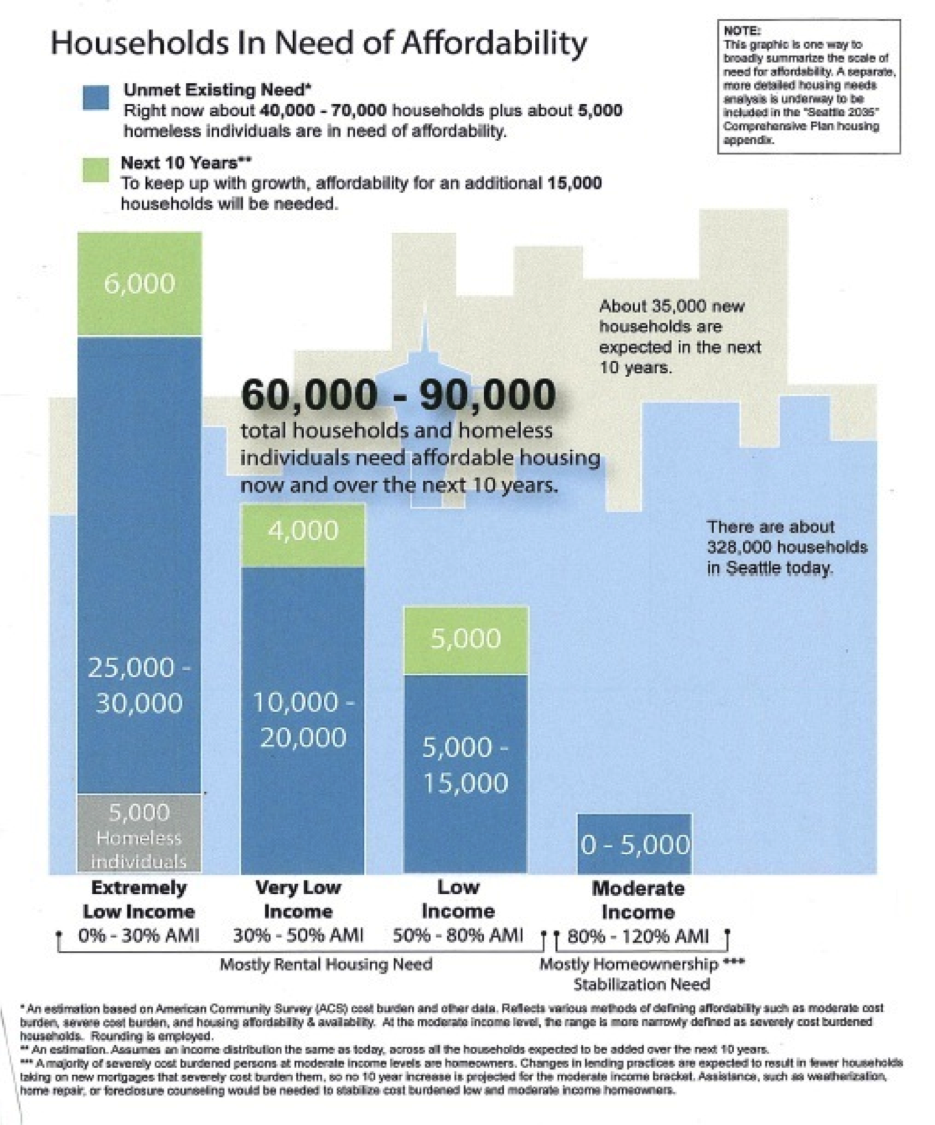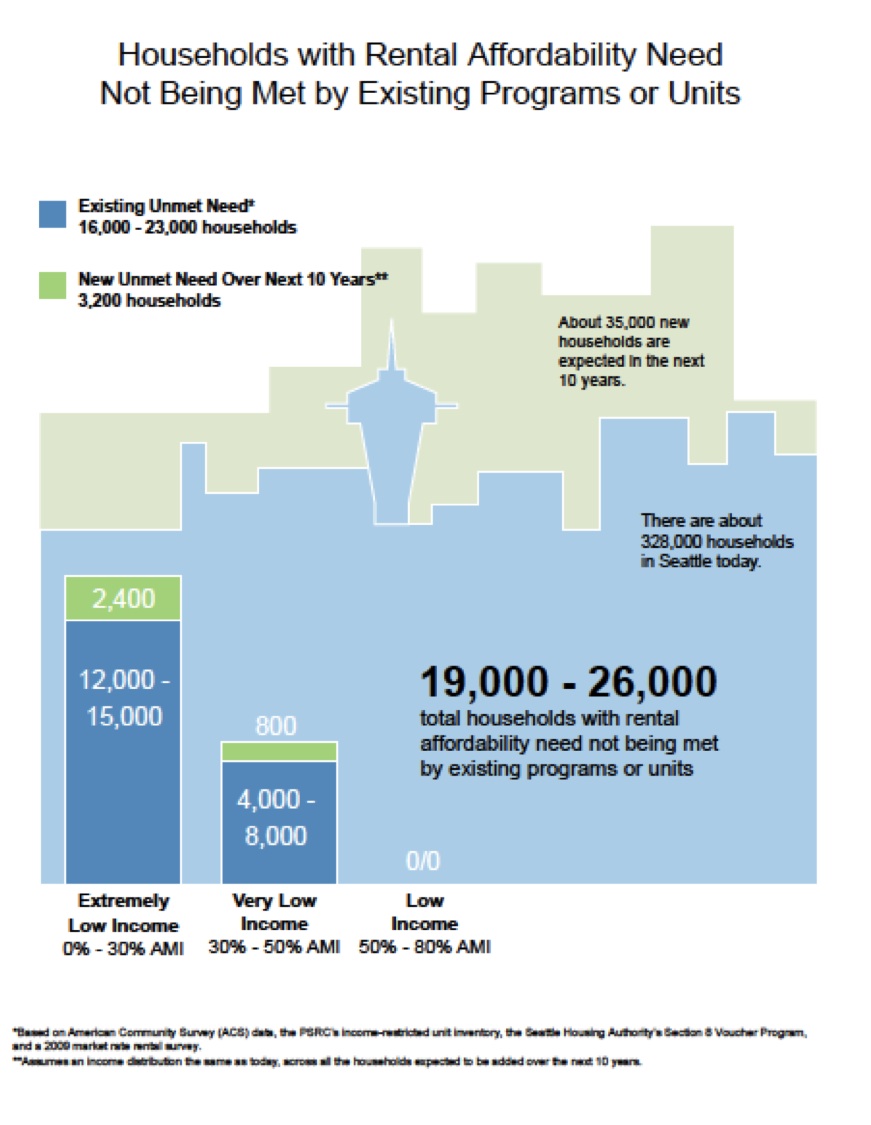Crosscut Festival Panel: Amazon Didn’t Raise Your Rent, the City Council Did
Two weeks ago I was honored to be a on a panel at the first Crosscut Festival, a wide ranging two day event with panels covering an array of national, regional, and local issues. My panel was called, Growth and Gentrification in a Tech Boomtown. I’m not sure exactly what the term “gentrification” means qualitatively or quantitatively. I get that there is a sense that the city is changing; it is. Some people feel the change is for the better and others think it’s for the worse. But how do we define and measure gentrification. If we take it literally, people of color moving out of a neighborhood and being replaced by white people, then we can measure that. I started my comments with some data showing that while indeed, in the Central District and Rainier Beach, an almost equal number of black people left the area to the number of white people moving in, other parts of the city saw increases in black households and decreases of white ones.
This doesn’t sit well with some, especially when I cited US Census data for the same period indicating that Seattle is becoming less white, one percent less white, that it has been. I also found that the median income of newcomers to the city is about $35,000, roughly half of the Area Median Income (AMI) of the whole city. So the notion that rich white people are squeezing out poor people of color just doesn’t pass the test.
Something is going on: housing scarcity. I tried to explain that if we want families of all races and economic status to have more choices about where to live, including staying where they are now, the best way to accomplish that is to build lots of housing. That way, price pressures on existing homes and buildings lessen and people in search of housing that are new to the area don’t bid up the price of existing and currently affordable housing.
The crowd wasn’t wholly receptive to this notion, with some clapping when I talked about more fees and fines being added to the production of housing. I told them if that’s their attitude, the problems of people with less money will only get worse.
It was a good conversation although I suspect it was mostly confirmatory of what people came in believing; it take a lot to change people’s minds. But I hope what I left was a bit of doubt about why things are happening the way they are. It isn’t the new growth and new jobs that are the problem, it’s our City policy makers who aren’t acting fast enough to give more incentives and encouragement to making more of a good thing, housing of all kinds, in all parts of the city, for people of all levels of income. You can listen to the whole discussion below.
Message Matters: What Do You Do?
It happens to everyone when you’re out and about, the question, “What do you do?” It is true for organizations too. The answer is important and has to be succinct; people don’t want a paragraph but a sentence, even two words. I am always refining how I explain our work and what we do. Over the last several years of being the director of Smart Growth Seattle and now Seattle For Growth, I’ve gotten the answer down to two words: more housing! This answer is rooted in the basic economic principle that when make make something scarce, it’s price goes up. The price of housing has become the red herring offered to stop growth, to tax it, or to distort in ways that benefit various interests.
It doesn’t hurt to repeat these things. It takes practice. What do you do? How do you do it? What does it sound like? Here’s my latest one pager.
Our Challenge
- City Hall isn’t listening to housing professionals who build and operate housing using invested and borrowed capital;
- They are listening to non-profit developers and some people in the community who are afraid of growth and change;
- The people they’re listening to don’t believe building more housing will lower prices which leads to bad public policy that makes prices worse and consumes public resources inefficiently; and
- We need to understand why and explore ways to persuade them that more housing is the solution, not the problem.
What We Do
Seattle For Growth advocates for building more housing of all types, in all neighborhoods, for all levels of income to create housing opportunity for everyone in Seattle.
How Do We Know We’ve Succeeded?
Seattle has a culture that sees new housing, people, and economic growth not as an impact that needs to be offset, but as an opportunity for people who live here and want to live here.
How Do We Get There?
Advocate, research, an communicate for more housing
- Typology – Shelter to Investment. We advocate for improving housing opportunity ranging from better shelter options through rental and ownership to opportunities for investment in the real estate market
- Location – Housing everywhere. There should be no part of our city or community where healthy and viable housing opportunities should be limited or restricted.
- Use – Zero zoning, more mixing. Zoning, the segregation of uses of land, is a 20th century solution to a 19th century problem. We don’t need zoning, but a code and rules that efficiently and appropriately blend many uses together including retail, housing, and even some forms of manufacturing.
How Does it Sound?
“Imagine a smaller, live-work home, near transit, that is less expensive in a densely populated, walkable neighborhood.”
Warning From Portland: Mandatory Inclusionary Zoning Brings Building to Halt
I’ve often said that I’ve never seen such intense and stubborn support for such a significant and sweeping imposition as I have for Mandatory Inclusionary Zoning (MIZ). There are two opponents in Seattle to the measure that the City calls Mandatory Housing Affordability (MHA), Seattle For Growth and angry neighbors who have appealed the program because they oppose additional growth and housing. The importance of stopping the program’s implementation can be found in Portland who is a year or so ahead of Seattle with a similar program. Housing production there has ground to a halt.
A story in the Portland Mercury has a headline that should cause anyone in the Seattle housing discussion to pause: Portland’s Bet on Forcing Developers to Build Affordable Housing Is Getting Lackluster Results. I’ll just quote liberally from the story:
A year ago, Portland City Council enacted “Inclusionary Housing” (IH), a new policy requiring any apartment building of 20 units or more to rent a portion of them below market rates—from 30 to 80 percent of the city’s median family income, depending on the option a developer selects.
When the city implemented the policy, detractors warned the new rules would simply ensure developers stopped building here. City officials argued IH would force the private market to create much-needed affordable units in Portland’s building boom.
A year into the policy, the detractors seem to be winning. Apartment construction in Portland has fallen off a cliff, though there’s still ambiguity as to whether IH or other market forces are the key reason. Meanwhile, Mayor Ted Wheeler is planning to sweeten the deals that the city offers developers to convince them to build.
It is hard to know exactly what’s going on. When looking at any economy, it is often only after the fact that one can determine a cause and effect. But the speculation is that many developers rushed projects through the permitting process to avoid the new requirements. Now building of new housing in Portland has come to a standstill.
“We’ve seen the spigot turned off so completely, so fast,” says Kurt Schultz, a principal at SERA Architects, who notes that his clients who’ve worked with similar policies in other cities often blanch when told of Portland’s strict IH rules. “I’ve never seen it turned off so fast before, and I’ve been doing this for 30 years.”
The same thing could be happening in Seattle; lots of projects rushing to get vested before the imposition of the new scheme. Here’s what I said in a post at Capitol Hill Seattle discussion the apparent fall off of design review applications:
Roger Valdez of Seattle for Growth suggested that some builders may have been rushing their projects through the process in order to beat the implementation of those new regulations. Now, he thinks some may be waiting to see what the final rules will look like. Until a developer knows what the rules will be, it’s difficult to know what projects will be profitable.
Until more certainty returns, Valdez said, there may be a bit of a slowdown, but he suspects it will be temporary.
I think Seattle will likely see a locking up of the market as buyers and sellers try to understand whether land is more valuable or less valuable with the imposition of MIZ, and once projects are vested, investors will likely wait to see how things shake out. That means not much buying and selling of land and not much new building. But demand will keep up. This means that what most agree is a slow down in rent increases will also stop; halted supply and steady demand mean prices will pick up speed again.
And then when prices begin to surge, investors will feel better about investing in Seattle projects again. This is a bad thing. As I’ve said a million times, MIZ “works” because it is entirely dependent on prices to rise to rationalize the fees and requirements. This doesn’t help the “housing crisis” everyone says they’re worried about. The imposition of MIZ, and even just the threat of it, is already creating enough uncertainty in the market that people are holding back. This is a recipe for higher prices, and when the rise enough in Portland and here, building will begin again. But that doesn’t help the consumer, especially the one who has less money to spend on housing.
Even if Non-Profit Units Cost $50K, It Would Still Make More Sense to Give Away Cash
Well, here I am again with criticism of the Mayor’s proposed supplement to existing voucher programs. The idea, giving vouchers to people struggling with rent in Seattle, is not a bad idea. But as I had suspected, it’s not a simple distribution of cash for rent. In fact, I’m not sure exactly how it will work, but there are three flaws with what I’ve seen so far: bad data, and math. Overall, the housing issue is one of priorities; do we favor quick, efficient solutions, or ones with more red tape and big capital expenditures.
Here’s what I know. The Mayor is in the process of selling a parcel of land in South Lake Union for about $11 million dollars. Out of that sale, she’s going to put $2.2 million into her voucher program. Her first executive order was to set the wheels in motion for the program.
That program is targeted at 149 households that for reasons I don’t understand “are deprioritized in the distribution of Housing Choice Vouchers and will likely not receive a voucher for several years.” These 149 households have annual income between 40 and 50 percent of Area Median Income (AMI) or somewhere between $25,950 and $43,200 per year for a family of three.
Now we don’t know the income of each of these 149 households but if we guess that they average out to the middle range of income 40 percent AMI, or about $34,560 annual income. If that’s the case, and we assume the worst, that the households are paying half their income, then here’s what that would look like for those households every month.
| Annual Income | Monthly Income | Housing Expense (30% of monthly) | Rent Shortfall |
| $34,560 | $2,880 | $864.0 | $536.0 |
So if Durkan’s program would, in fact, just cover the difference, it would cost about $2 million for about two years.
| Monthly Cost | Annual Cost | Two Years |
| $79,864.0 | $958,368.0 | $1,916,736.0 |
I don’t think this is what Durkan is going to do. Based on the first information coming out of the administration, the City isn’t going to cover the difference, although this would make the most sense. Why? Seems like a lot for two years and just 149 households, right?
But let’s consider that these households are already housed somewhere in Seattle, they’re just paying out a lot of their income as rent. It’s driving the non-profit housing people crazy when I say that based on total project costs and units created that their projects cost $500,000 per unit. Fine. Let’s assume it would cost half that to build units for those 149 people. The total cost would be, $37,250,00. And to operate those units for two years would cost, if we assumed a low-end cost of $5,000 per unit, or about $1,490,000.
So, based on the math (and remember I am a philosophy major) just paying down these holds rent with the money from the sale would make much more sense that building them units. A lot more sense because it could be done tomorrow if the bureaucracy wasn’t in the way. It’s doubtful that Durkan’s program will just allow people to submit a rent receipt, a pay stub, and their bank account information; but it should. I’ll say more on that later.
How about the persistent claim by the City cited in the Mayor’s Executive Order about how many households there are between 30 and 50 percent AMI that need help.
WHEREAS, 2014 analysis conducted for the Seattle Housing Affordability and Livability Agenda (HALA) committee found that approximately 10,000 households (renters and owners) earning between 30-50% of AMI are spending more than half of their income on housing costs and are considered severely housing cost burdened
It’s kind of sad to see that cited as if it were fact. For one, notice the nice round edges of that number, unlike the ragged 149 mentioned as the focus of initial resources. We already debunked these numbers back in 2014. Remember these two graphics? The first is what the Mayor is referring to which is wrong, and we created the second as a comparison. The City subsequently abandoned these numbers in the first graphic. It’s like seeing an old friend to have them trotted out again.
You can see before we removed all the available existing resources and housing units (actual rent restricted units created by MFTE, non-profit housing, SHA housing, vouchers etc.) the City was suggesting the number of households that needed some help was between 10,000 and 20,000. When we applied reality to their census numbers from 7 years ago, the number dropped to less than half that figure.
If, and this is a huge if, the number of households needing help in that income band numbered 5,000 and we applied the same math as we did for the 149 households, it would look like this:
| Households | $500 cash per month | For two years |
| 5000 | $2,500,000 | $60,000,000 |
Again, let’s assume a big discount from my cost per unit total that I think is real but feverishly disputed by non-profits; let’s say the cost per unit is only 10 percent of what I have suggested or $50,000 per unit. I’m trusting my calculator here, but the number is $50,000 per units X 5000 households and when I hit this button “=” the number is $250,000,000 excluding annual operating costs. Building 5000 units would take a long time, probably a decade given current production levels of non-profit housing.
Again, the non-profits are Yosemite Sam mad about me exposing the costs of their projects, but the fact is that 88 units at CHIPs 12th Avenue Arts and 112 at El Centro de la Raza’s Beacon Hill project cost a combined total of $92 million dollars. I know that the money is a mix. I know it’s complicated. I know “it doesn’t work like that.”
But leadership, if we had any, would look at the data, the math, and task the bureaucracy to figure out how to get all that money to those households quickly. And that leadership would do that rather than extorting cash from the market, raising market rate housing prices, to create those units way off in the future.
But I’ve got some good news! We’ve already built the website, called helpmewithrent.com. All anyone has to do is put in their income and rent and the calculator kicks out how much money the Mayor could direct deposit to a bank account. Is that going to happen? Well, the next report from the Mayor’s task force is at the end of March. I suppose those households will have to wait until then.
From a Small Landlord: If Rules and Politicians Aren’t Helping, Get Rid of Them
Here is another story from someone who provides housing sharing the mess being created by the City Council for people trying to make a living providing reasonably priced housing. We’ve also shared a couple stories from builders facing similar troubles trying to build housing and worried about rent control. The City Council has ceased to function as a rational policy making body when it comes to housing. Here’s how new rules are impacting one small landlord.
First a little backdrop:
My husband and I are very small-time landlords, with only 2 buildings in Seattle, a triplex and a SFH. The properties are a key component in our retirement planning, and both of us work full time engineering jobs.
We tend to have very long-term tenants because our practices keep them happy. This isn’t just because we are nice. Aside from the very occasional giant repair, only tenant turnovers make land lording a temporary, full-time job. So we hate turnovers, and avoid them as long as reasonable. We want this as passive as possible while we head to retirement.
Bureaucracy
As you can imagine, one thing making it hard to be passive is the amount of change and bureaucracy coming from city hall. This is easy for a big company to track as they have full time employees watching and lobbying. Not so much for us small fries.
Stupid Example: Voter Registration.
Is that a very reasonable sounding ask that landlords give tenants a voting registration card? Sure, sounds simple. BUT! What happens if I don’t do it / didn’t know / didn’t remember? Honestly, I have no idea; I can’t find that information online. I’m just relieved I happened to read about it since there is no systematic way to find out this information without paying for a service like the one the Rental Housing Association of Washington has (who are great). What else am I missing? I frequently worry.
More serious example: RRIO
I signed up my triplex for RRIO in Jan of 2017, as required. I was told that I would get called up to inspect sometime in the next 5 years. That’s crazy on its own, that I need to expect the next step of bureaucracy anytime in the next 1,800 days. But ok
Evidently the city sent me a letter eleven months later telling me I was up for inspection. I missed this letter. Yes that’s on me (assuming it was sent) but there are five adults living in my house and sometimes we lose mail.
I got very lucky and looked at the RRIO website out of curiosity for a political debate I was having and found that my triplex was due THAT DAY! I called and got an extension (grateful for that, the city employees are very nice and cooperative). But had I not noticed, then evidently, I would be facing $150 / day fines for ten days and $500 per day fines after that.
Shouldn’t a fine that like at least require certified mail given the five-year span in which it might come?
You know, who wouldn’t miss such mail? Companies devoted to nothing but land lording. You know who might? Small fries like me.
I did end up passing but this was a giant stress, for no tenant gain. None. They were fine and happy already; Just another stress, slowly pushing me out of the city.
In short, like all bureaucracy, ours favors the big guys. Continued rules continue to favor them.
If Seattle likes us small businesses, Seattle should stop putting in rules as though their impact were inconsequential. And it should be required to measure the actual impact of their rules. If they aren’t helping they should be cut. And so should the politicians peddling them for votes.








